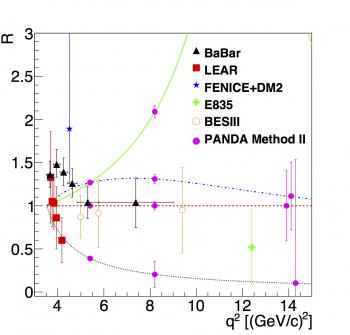The dynamical view of the internal structure of the nucleon is conveniently described in terms of ‘electromagnetic form factors’, that contain the information on the charge and magnetic currents created by the constituent quarks and gluons. Electron scattering allows to characterize the nuclear matter, which distribution within a radius of 1 fm (10-15 m) is far from being uniform. This matter can be created in electron-positron annihilation or annihilate when matter and antimatter collide in a proton-antiproton collision. The same form factors formally enter in the description of these reactions. They bring the secret of the matter creation from the quantum vacuum. IRFU, following pioneering experiments at Saclay (ALS), participated to several experiments in this topic, in scattering reactions (at Jefferson Lab, USA) and in annihilation reactions (SLAC, USA). A future experiment will measure these form factors in a large kinematical domain: the PANDA experiment at FAIR (Darmstadt,Germany). A realistic computer simulation of the expected precision of this measurement has recently been published in the EPJA and selected to make the cover page of the journal. The expected precision of the reaction: antiproton-proton annihilation into a lepton pair, will allow for the first time the individual determination of the electric and magnetic form factors in the time-like region.
How the constituents of the matter, the quarks and the gluons, do interact?
Electromagnetic form factors offer an essential information on the dynamical properties of this interaction. They acquire, however, a different meaning in the different kinematical regions. In the scattering region (called space-like) they carry the information of the spatial dimension (the electric charge density), whereas in the annihilation region (the time-like region) they carry a time-dependent information, that can be interpreted as the formation time of the quark-antiquark pairs from the quantum vacuum and of their evolution in time towards the formation of a proton-antiproton pair.
The reaction of interest here is the proton-antiproton annihilation into a lepton pair. The experimental challenge consists in detecting an electron-positron pair hidden in a hadronic background that is more important by several orders of magnitude. Indeed, the initial particles being hadrons (i.e., particles driven by the strong interaction) the probability to create hadrons is millions of time higher than leptons (particles driven by the weak and electromagnetic interactions), in particular electrons and muons. The most difficult reaction to be subtracted from the background is definitely the production of two charged pions, as the pions are the lightest hadrons and the momenta of pions and electrons are comparable. The reconstruction of the kinematics allows to reject the reactions with more particles in the final state, the neutral pions that disintegrate into two photons, as well as secondary particles. Most of all, the reconstruction of the energy loss in the electromagnetic calorimeter is discriminative for the identification of electrons with respect to pions.
?The development of the simulation and analysis code PANDARoot has done enormous progress, following the construction of prototypes and their tests under beam at CERN, Mainz or Bonn. This gives confidence in the reliability of the simulation and in its predictive power.
Although the procedure of extracting the form factors from a precise measurement of the angular distribution of the scattered electrons is well established, we have developed an original method with a fast algorithm based on the analysis of the angular asymmetry [2]. The shape of the angular distribution, linear in cos2θ, where θ is the electron emission angle in the center of mass system, depends on the relative value of the electric and magnetic form factors. Their ratio has already been measured, but with large error bars. Theoretical models built to reproduce form factors in the space-like region, give different predictions when extended to the time-like region, showing the necessity to develop nucleon models that have the necessary analytical properties to be applied in the full kinematical region.
Our analysis shows the large precision with which electromagnetic form factors in the time-like region will be obtained in next future (Fig. 2), assuming an integrated luminosity of 2 fb-1 that will be obtained in four months beam time (per point).
The amplitudes being complex functions, the relative phase has to be known. This will be possible with a polarized beam or target. The option of a polarized target is presently under study.
Such measurements will scrutinize the details of the formation of proton, in particular to the first steps of its creation and to the underlying mechanisms. The possibility to access the fourth dimension, the time, opens the perspectives of a new interpretation and understanding of the strong and electromagnetic interactions.
Contact: Egle Tomasi
Références :
[1] Feasibility studies of time-like proton electromagnetic form factors at PANDA at FAIR, B. Singh et al (PANDA Collaboration), Eur. Phys. J. A52 (2016) 325
[2] A. Dbeyssi, PhD Thesis, Univ. Paris-Sud, 2013.

Fig. 2 : Absolute value of the form factor ratio in the time-like region. The data measured by the BABAR and BES collaboration (électron-positron colliders), the results from LEAR at CERN (antiproton-proton collider) as well as the results obtained from the simulation, depending from the possible values of the form factor ratio. Our analysis (pink circles)) shows that this ratio will be measured with a large precision at PANDA in a wide kinematical domain.
• Structure of nuclear matter › Quarks and gluons hadron structure
• Institute of Research into the Fundamental Laws of the Universe • The Nuclear Physics Division
• Nucleon Structure Laboratory (LSN) - The internal structure of hadrons
